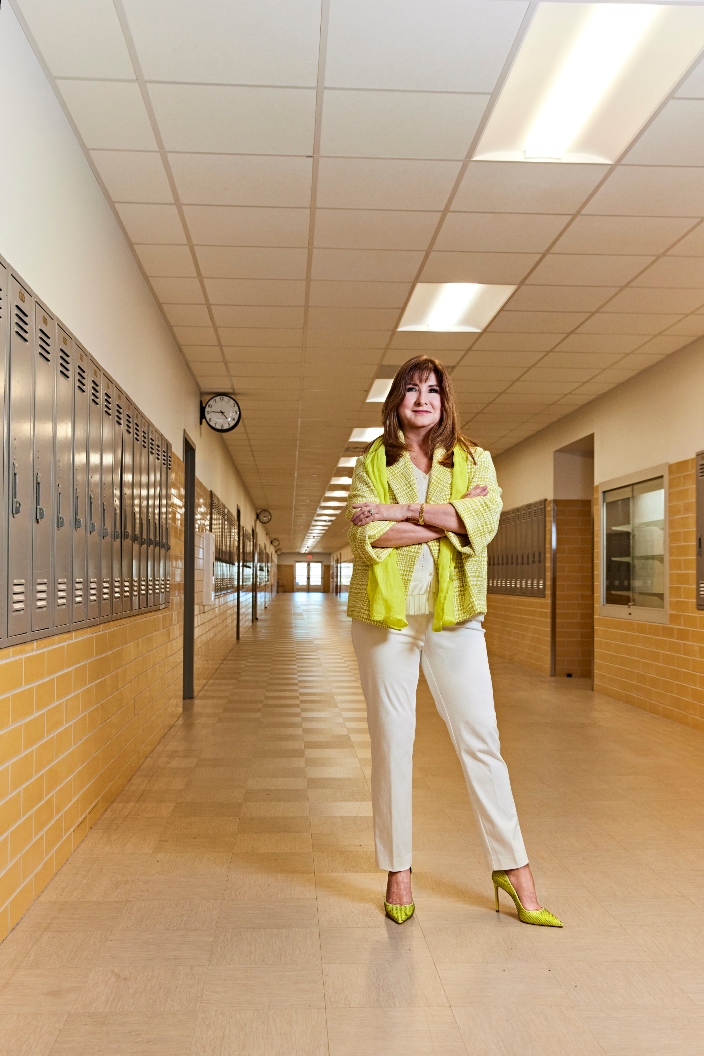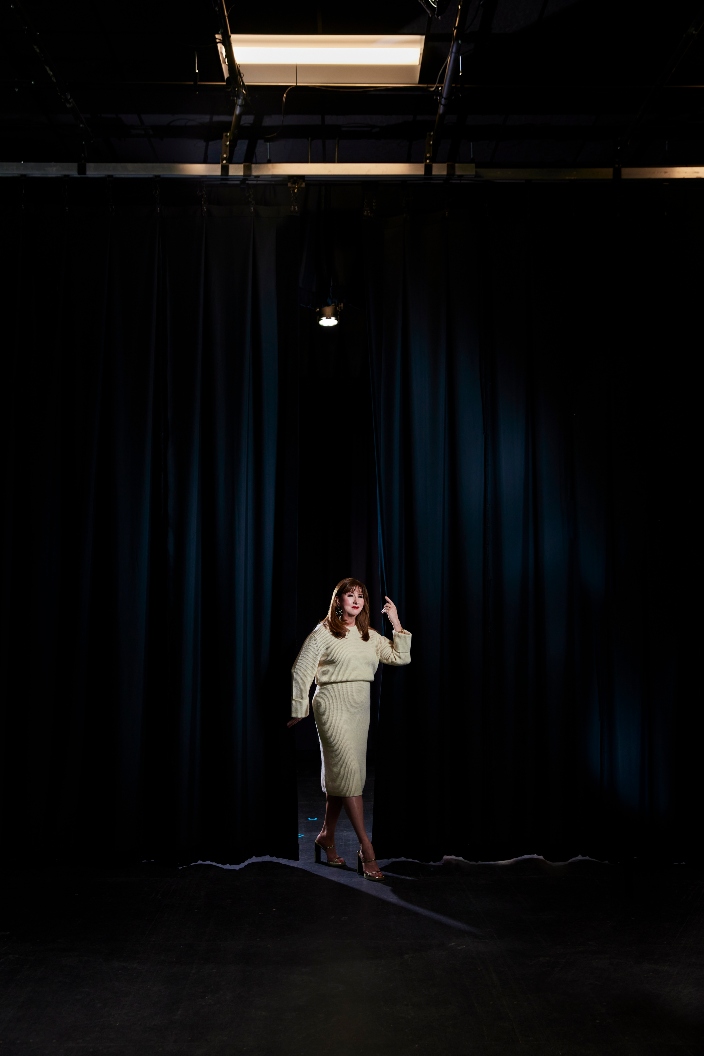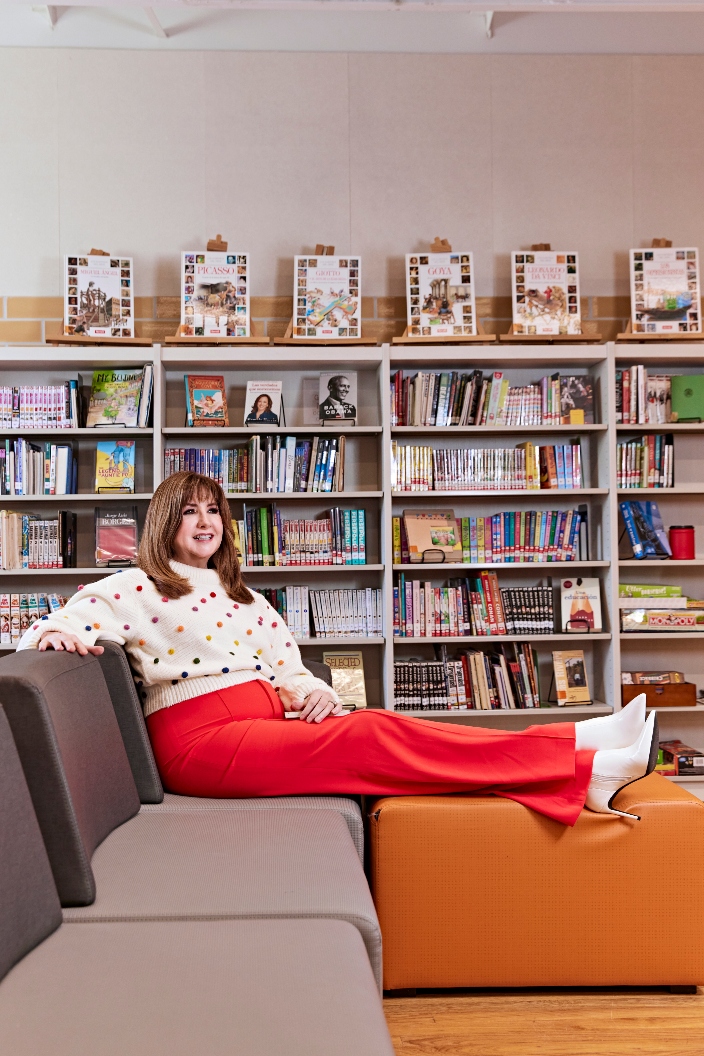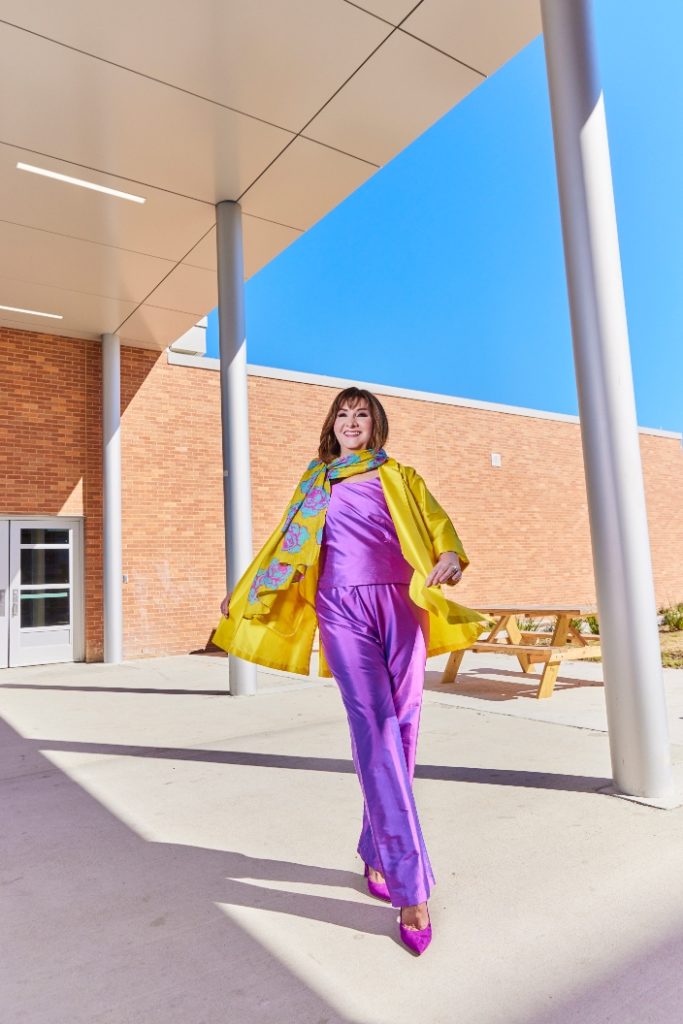Austin ISD Superintendent Dr. Stephanie Elizalde gives her all to serve her community and the children growing up in it.

By Cy White, Photos by Annie Ray, Styling by Parke Ballantine with inspiration from Garden Room Boutique and Nordstrom Domain, Makeup by Jackeline Lara, Hair by Guadalupe Santamaria, Shot on location at Eastside Early College High School
No one ever tells a hurricane to behave. When the powers that be tried to make her step in line, Dr. Stephanie Elizalde, Austin ISD’s superintendent, refused to sit quietly. With the audacity of a winter storm in Texas, she made her stance clear to Time magazine and the world on Aug. 15 of last year: “I cannot live with a tragedy occurring because I was afraid of the possible consequences…That is just not something I’m willing to take the chance on. I realize, of course, that…may mean that we will be fined for requiring masks. I’d rather pay money than risk a child’s life.”
Many in her position would do all they can to stay under the radar. Do what they’re told in order to maintain the facade of “normality” for the status quo. But Elizalde is made of sterner stuff. A third-generation educator, she comes from a long line of people refusing to be put in boxes. She grew up understanding that she was meant for greatness in the face of even greater opposition, and with that greatness came a responsibility to invest in the community, to be a blessing to those for whom blessings are few and far between.
“My dad absolutely admired John F. Kennedy, Robert Kennedy, Martin Luther King, Jr.,” she says. “And he loves music, so he would play records. He would have my sister and I sit and listen to the words because he communicated to us much of his desire for what he wanted us to be. And by that I mean it wasn’t like he wanted us to be this profession. It was what he wanted us to be as human beings.
“There’s a song that goes, ‘Has anybody here seen my old friend John?’ [My father] would have us sit down, and we listened to it.” She pauses for a moment, the power of the memory causing her eyes to water a bit. “You know, even thinking about it, sometimes I may get a little teary eyed.” She composes herself, then, “My dad would say, ‘These men lived under a code: to those who much is given much is expected.’ Those words resonate with me. Like, if I don’t do something for others, personally and professionally, then I’m gonna feel like I let my parents down.
“My purpose is in being a public servant and feeling that we grow teachers who serve students. There can be no better calling than creating the next generation of leaders.”
Born and raised in Laredo, Texas, Elizalde recalls her childhood not necessarily being one of plenty, but certainly one where she never felt like she went without. “We grew up, I would say middle class, but I would definitely say lower-middle class,” she says. “Most of the kids that were in my schools seemed to have quite a bit more things than I did. Went on vacations and did things that I wasn’t familiar with. I did not know what snow skiing was. But I had friends who were like, ‘Oh, we’re going to Breckenridge.’ I’m like, ‘Where’s Breckenridge?’
“I can’t ever say that I didn’t have food on the table or anything like that,” she says “Those were not the concerns that I had. Yet I did feel for a long period of time that I was less than many of my peers. My mom sewed our clothes. They were really cute, but she sewed them. They weren’t the brands that my friends were wearing. So I had to learn how to get through that.”
Education was always paramount in her household. The granddaughter of a teacher and the daughter of a principal, every moment was an opportunity to learn. “My parents always instilled in us that education was the great equalizer,” she says. “My dad, being a teacher, would really spend a lot of time actually teaching me things at home before they were going to be taught at school. Then my mother, while not having a college degree, is an avid reader.”
It’s her mother, in fact, who made sure her children never felt left out, engendering a confidence to do whatever their hearts desired. “Interestingly, she would see what her bosses were doing with their children,” she reveals. “She saw them putting them in dance. So she’s like, ‘Well, then I guess my girls need to be in dance.’ She saw them taking equestrian lessons. So then she thought we needed to take equestrian lessons. She saw them studying piano. My mom worked a second job to pay for those things.”

Her education was never strictly about books and homework. A multi-ethnic household meant everyday was a new adventure, a new lesson learned. In an interview with The Texas Tribune’s Evan Smith, she called herself the daughter of Lucy and Ricky Ricardo. It’s an apt description—with a spirited mother and opinionated father, there was only ever one outcome for their eldest child. “I got the best out of both of my parents,” she says. “I have a strong-willed mom and a very strong, very empathetic father. My mother didn’t not bring her German heritage with her,” she insists. “Nor did my father lose his Mexican ancestry or customs. As they raised my sister and I, we had both. So, you know, one day we’re eating menudo and tamales, and the next day, we’re having bratwurst and sauerkraut, or fried gizzards.”
This upbringing instilled in Elizalde an ardent love of music and the arts. Along with her natural inclination toward adventure, this gave Elizalde all the motivation she needed to pursue her first love: dance. “I never wanted to be a teacher. I never wanted to be a teacher growing up, except I always played teacher,” she says, giggling at the memory of always bossing the neighborhood kids around, teaching them what she’d learned.
But teaching was never a part of the plan for her. Her heart was in the pulse of a flamenco, the elegant lines and rigorous discipline of ballet. “My mom exposed us to taking classical ballet and Spanish flamenco since I was probably about 2 or 3 years old, until I left Laredo for college,” she remembers. “Those were some things that really became a part of who I am. Who knew that dance would be something that would help me in public speaking or that would help me remember that someone’s always watching, that you’re constantly on stage?”
But, as most creatives can and do openly attest, passion doesn’t always equal a paycheck. She turned her sights on another, more practical love: science and math. “I took every math and every science course because I wanted to be a doctor. And so my bachelor’s degree is actually in biology, and I was pre-med.”
It was while preparing for the MCAT that she made the decision to seek employment. After all, a medical degree is nice, but unless recruited right out of undergrad, jobs aren’t necessarily falling from trees. She needed a job, point blank. While living in San Antonio and perusing the classifieds in her local newspaper, she came across an opportunity that seemed too good to be true.
“There was a dance teacher position at Southwest High School, right on the outskirts of San Antonio,” she remembers. “Not even thinking about what my degree was or what it aligned to, I called. I did a little research on the school. They were the Southwest High Dragons, and their colors were kelly green and black. Well, I only owned one suit; it was black. And I had a kelly green blouse. So I put on my kelly green blouse and went in the school colors.
“‘]Of course, they looked at my resume and were like, ‘You don’t qualify to be the dance teacher.’ I’m like, ‘But I studied ballet.’ They’re like, ‘Yeah, I get that, but your degree is not in dance. But we are starting a new high school science teacher position that will teach anatomy and physiology. You are just the perfect candidate for that. Do you want to teach?’ I was like, ‘Sure, but I’m not certified as a teacher.’ They said, ‘Oh, don’t worry. We’re going to get you certified through this thing called the alternative certification program.’”
The stars aligned, as they say, and Elizalde set off on a path she never expected. “That was August of 1987. And I stayed in that district for 16 years.” The revelation yanks a hearty laugh out of the reluctant lifelong teacher. “I rose through the ranks in a very traditional kind of manner. I was a teacher, I was an assistant principal, I was a principal, I was director and then ultimately got a job in the San Antonio Independent School District, a much larger district than the one I was [originally]in. During that time, I was the cheer sponsor. I was the student council sponsor. Anything they had that was going to involve extra hours with extra kids, I was on board.
“I was gonna go teach for one year. One year. And I was horrible my first year.” Another round of warm laughter. “But once I got in that first year, I knew that truly all this time I had been fighting against what I really wanted to do. What the love for education was and how privileged I felt that I had gotten a great public school education. I was now in a school where I could see not everybody was getting the same quality public education that I had gotten. What could I do to make a difference? So here we are 35 years later.” Her smile is radiant and honest. Love, absolute and open, wraps every word she says in a bit of gossamer.
A hurricane doesn’t care what you think about it.
Whether at the ballet bar or standing at the whiteboard, Elizalde always believed she was called to serve. But her journey from “the daughter of Lucy and Ricky Ricardo” to Austin ISD’s superintendent was really a quest for one thing: identity. “Laredo is largely Latino,” she says. “There was an airbase at the time, so there were whites and African Americans, very few, but they were there.
“I ended up getting more of my mother’s coloring than I did my father’s,” she continues, “so just looking at me, many times people will not recognize that I’m Latina. I’m Mexican American, but truthfully, there were quite a few Hispanic kids who didn’t want to play with me because I looked too “white”. And there were some white kids who didn’t want to play with me because I was Latina. So it was a struggle in terms of trying to decide who I needed to be in order to assimilate within that group. School then became a really important part of my identity as I struggled with my ethnicity.”
Even while wading through whispers and internet chatter about how she should present herself, Elizalde refused to let those who knew the least about her force her to assimilate to their notions of respectability. In her mind, there was never a question of choosing. “To be quite frank, it wasn’t until I came to Austin and was reading some social media, which I try to stay away from these days. Someone said, ‘I don’t know why she can’t just use her mom’s name. There’s no need for her to identify as a Latina. She’s just as much white as she is Latina. Why is the Latina the spotlight?’
“I didn’t think I was really either/or. I thought it was both/and. So it just gave me that kind of reflection: We may all be wearing glasses, but we don’t see through the same lens. It was the very first time that it ever occurred to me, ‘Would things be different if I identified more with my mom’s side than I did my dad’s side?’ That never crossed my mind until I read that post.”
A hurricane does not apologize.

Outspoken, unapologetic, honest. Even when her honesty gets her into a certain amount of trouble, Stephanie Elizalde is tactfully fearless. However, she can’t deny that there are times when her position as a woman (and a woman of color) has given her cause to shrink herself, or at least dim her shine a bit in order to feel less conspicuous. “I would not be truthful if I said that I haven’t had some of those internal conflicts,” she admits. “It would not be true, and it wouldn’t be in keeping with who I am. I always know [my identity]is a tough topic, and I’m going to handle it the way I handle everything else.”
The same woman who stood toe-to-toe with the State about mask mandates in schools has also had to grapple with multitiered bouts of self-doubt. Dr. Stephanie Elizalde, the woman who garnered national attention for standing in her truth and her unwavering dedication to the children in her care. The same Dr. Elizalde who penned a letter in Time magazine explaining her stance to the nation.
But those moments of uncertainty never stopped her from living in her truth. Admittedly, she wouldn’t know how not to be herself. “I’m not smart enough to keep up pretenses,” she says, a hearty chuckle coloring the admission. “I can’t try to remember, ‘What did I say when I met with so and so?’ because you’re trying to mold yourself into something that you think someone is expecting. I do consider that a strength that I have. I think that came from the struggle of, ‘Am I Latina, or am I white?’ Who knew that that struggle would actually have some similarities to being a superintendent?
“I have heard people say things like, ‘Well, it would be helpful if you would soften the way you speak a little bit. It would help if you weren’t so formal in the way in which you dress or the way in which you carry yourself. It would be helpful if you would be a little more emotional.’ The first thing that clicks in your head is, ‘Would they make those comments to a man?’ Right?” As a woman, the blessing and curse of existence is having to navigate a world that refuses to accept the complexity of womanhood.
As a woman in leadership, one has to also be a master magician: be everything and nothing at all. “There’s two things you can do with that,” Elizalde offers. “One, you can totally discount the feedback. Then there’s the other extreme where you start to lose your identity because now you try to become what a few folks have told you might be helpful. I think it’s important to do a little bit of both. Listen to the feedback, because I can’t say I’m an educator and then not try to learn. I think it’s equally important that I not get lost in trying to become someone I’m not. I do want to become the best version of me. But I’m gonna have to be me.
“Mary Poppins says it best, ‘I’m perfectly imperfect.’” The iconic English nanny swooped in like a hurricane herself, teaching children how to better themselves in a world that either caters to them for what they have or lionizes them because of what they don’t. It’s apt that Mary Poppins is her favorite film. “I can do supercalifragilisticexpialidocious. I can even say it backwards, which is suoicodilaipxecitsiligarfilacrepus, but that’s going a bit too far, don’t you think?” She says this all with a smile that utterly gleams with childlike mirth. “I’ve watched Mary Poppins a few times.”
However, the people in her life who’ve made a lasting impact were just as integral as Julie Andrews’ interpretation of the magical governess. “My parents, the teachers and principals who worked with me in Dallas ISD. It’s their success that got me noticed for this position. If they weren’t doing what they needed to do to accelerate student academic achievement in Dallas, I wouldn’t have even had an opportunity, I think, to even make the first cut, let alone anything else in Austin ISD.”

Because They Loved Me
“There’s a song attached to a movie. Michelle Pfeiffer plays a reporter, and Robert Redford [is in it]. That theme song says things like, ‘You lifted me up when I couldn’t reach.’ That to me embodies what my parents did for me and my sister. No families are perfect. But they did the very best they could, and they always, always emphasized how important school was.”

What are three songs you listen to when you need to get fired up?
I have to do Michael Jackson, “Man in the Mirror.” I use that as a theme, I can’t even tell you how many times. I would go to a different school in a different school district and would say, “We need a theme! Let me think about it. ‘Man in the Mirror.’” It would automatically come.
Of course, Anita Baker. I think “Angel.”
And I’m going with Helen Reddy, “I Am Woman.”
Her circle of influence widens exponentially when accounting for her only son, William. The omnipresent question of identity confronted her with absolute gale-force power. It’s a subject all career-driven women are forced to address: motherhood. “Like every other parent, regardless of the position that we hold, everything we do we do for our children,” she says. “I did choose to have only one [child]because of my career.”
Then the mood of the conversation takes a sudden shift. A memory, tough like gristle, sits heavily in her heart. She clears her throat a few times, shifts a bit in her seat. “When I had William, I was at Southwest ISD. It is an area where there’s a lot of high poverty. Some of my kiddos lived like what I’ll describe as tenant farmers. They worked land. Southwest is semi-rural, semi-urban, on the outskirts of San Antonio. There were landowners that had lots of vegetables and fruits and things that they sold, and most of those individuals sat on the school board. But the children that I served, many of their parents worked for those landowners, picking crops and so on. So it was really important that if there was some resource that I could get out to kids, that I did so.
“But there was one of those moments where I had to recognize how much time this was taking away from my family, specifically my son. He was about 5 years old. It was a winter break, and we were taking gifts and food to kids who probably weren’t going to have anything for the Christmas break. I wanted him to see that everybody doesn’t live the same way. My sister even dressed up as Santa Claus and helped distribute the gifts. At the end, [William] pulled me aside and said, ‘Mom, what do I need to do to be one of your kids?’”
Pause. Silence. Settle. Compose.
“It was at that moment that I decided I needed to not invest in any more of my own biological children,” she says after the moment. “That I needed to balance a little bit what I was doing to ensure that my own child felt like he was mine. From that moment on, I carved enough time out to be at every one of his football games, every one of his baseball games. I went to every single parent teacher conference. We went to karate exhibitions.
“I know if we had had more children, there would have been no way to have continued on the career path that I was leaning toward. Not that at that moment I ever thought I would be the superintendent of any district, let alone the capital city of Austin ISD. But I did know that I wanted to ascend in the school business in an organization. So it was a moment of reflection, a moment of having to reprioritize. I’m simply blessed that it happened early on enough. That it wasn’t when William was 18 that this happened.”
In the eye of the storm.
Things come full circle. As it was growing up, so it is now for a woman who’s made serving her community and its children her life. Dr. Stephanie Elizalde knows what must be done and she’s dedicated to making it happen. “Everybody isn’t getting the same quality public education in the state of Texas,” she says without batting an eyelash. “That’s a really hard thing for me to say, because I am a believer that if you are not part of the solution, then you’re part of the problem.
“I can’t say that and point fingers; I have to take responsibility for my part. That’s why I’m so dedicated that Austin ISD can be the beacon that demonstrates that we really can be a public school district, not a district of public schools. That [we]come together to support all of our students, regardless of what part of our community they live in. I got such a great education. So then there’s guilt: ‘How come we’re not doing that for every single kid?’
“The solutions are not as simple as people may think they are. These are complex systems, and we can’t ignore the institutional racism that has affected the creation of our school districts. They were created to separate us, so we have to realign our philosophies. Acknowledge the past, but we also have to look to the future with brightness. We have to see the horizon. It doesn’t do any of us any good to be Debbie Downers. I never saw anyone who wanted to work for Eeyore. We have to deal with those feelings, and then we just have to move on.”
Moving forward, Elizalde is ever hopeful. “What has been revealed to Austin ISD is the number of community members, teachers and principals who want to be the difference. Who want to make the difference and, as cheesy as it is, who want to live out the starfish story. Even if it’s one starfish at a time, one student at a time, one classroom at a time, one school at a time, we can make Austin ISD the public school district with high academic achievement for every one of our students.”

